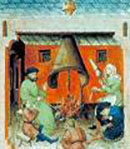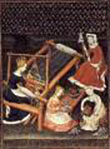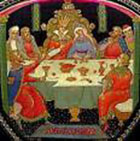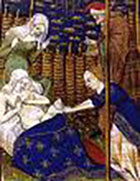Past Talks
The Medieval Household
Date: 16th July 2007
Speaker: Dr Elizabeth Gemmell
The Meeting was held at St Edburg’s Church Hall, Bicester. Thirty one members and four guests attended the Meeting. Bob introduced the speaker, Dr Elizabeth Gemmell.
Records relating to what households were like mostly derive from ecclesiastical or noble households. Accounts survive describing the organisation of households and how they were run. Travelling chroniclers provide objective views of the households that they visited.
The medieval household represented a small social unit and provided a series of functions such as eating, work, display and leisure. Within the medieval household a large number of private functions were held in public. Households in C13th – C15th can be identified as:
- Ecclesiastical Households: Communities living together to serve God. Cloister built adjoining Church. Some went into Church for social reasons and power rather than spiritual purposes.
- Aristocratic Households: Grandest form. Royal Court at pinnacle. Many fortified castles designed in defensive mode with Great Hall for meals etc (Conwy Castle). Later castles more social factors included and built as residence rather than for warfare. Lord’s family as well as servants, retainers and visitors lived in the household. There were as many as eight hundred people connected to a royal household.
- Other Households: Country homes/cottages and town houses. Towns grew around castles/monasteries. Merchants’ houses had store rooms adjoining, artisans had workshops and accommodation for apprentices. Some 80% of the population lived in the country. London was by far the largest town. Materials often dictated the types of houses. Peasants had fewer possessions.
The great medieval households are the most recorded. There were separate households for the King, Queen and eldest child. Royal children were often sent to experience other households. There were strong links between the Lord and his retainer. Livery was distributed and badges to identify specific households. Clergy were employed to keep records and administer to the spiritual needs of the family. Various jobs were specialised e.g. buttery. Most households were dominated by male retainers. Few women held positions although this changed following the Black Death. Hospitality was important and guests were well treated.





Many households were self sufficient, living on produce from their own estates. Wine and spices were imported. These were a sign of status. Nobles would eat more meat than peasant families. Fish was important at times of fasting. Wednesdays was a fasting day. Little milk was consumed but cheese and eggs were important. Ale was consumed rather than water. The Lord had fresh bread. Few vegetables found their way into the diet.
Eating was seen a ritual with washing, prayer an important part of the process. Left over portions were distributed amongst the poor. Feasts were held at appropriate times e.g. Harvest, Christmas. The meal was often accompanied with readings taking place or entertainers performing. Social position was important with obedience shown to those above you and kindness to those below your station.
The meeting finished at 8:55pm following a question and answer session.
